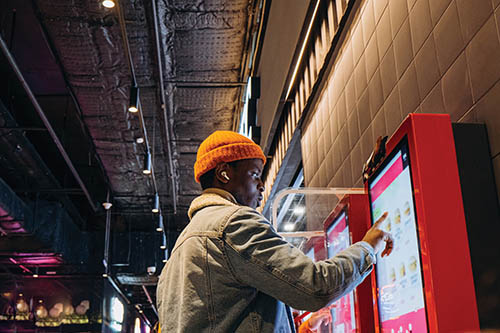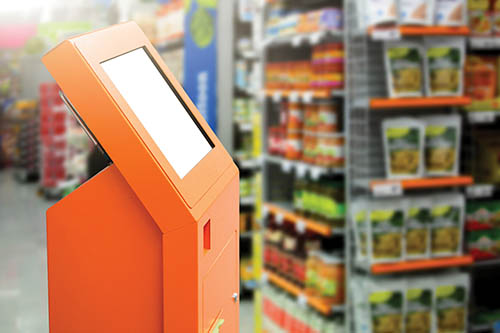— By Chris Jernigan —
Meeting the evolving needs of the multi-site facilities sector.
The landscape of multi-site facilities management is undergoing significant change. Looking ahead, it is crucial to anticipate and meet the evolving needs and expectations of customers. Companies are constantly seeking ways to distinguish themselves and enhance the customer experience. For facility leaders, this means being prepared to support new projects and ideas as they emerge. However, in focusing on the latest trends, we might sometimes overlook customers who do not fit into these advancements.
I recently encountered this issue firsthand at Hartsfield-Jackson Atlanta International Airport. I stopped by a quick-service restaurant that had implemented kiosks for ordering, intended to expedite the process and allow staff to focus on food preparation. Unfortunately, I observed an elderly couple struggling with the technology, unable to place their order and clearly frustrated. No staff member offered assistance, as they were preoccupied with fulfilling orders received through the automated system.
This incident made me reflect on similar experiences across various retail and dining environments, where increasing technology use such as mobile apps and robot servers creates different customer interactions. These changes present an opportunity to cater to multi-generational customers, ensuring a positive experience for all.

I believe there is value in adopting a “middle ground” approach — integrating automation without completely abandoning customer service. This approach benefits everyone: customers receive necessary help, leading to more efficient use of the machines, and businesses still reduce labor costs by cutting fewer cashier positions. The overall outcome is improved satisfaction.
Technology’s intent was never to ignore the customer experience, but there appears to be an over-emphasis on automation at the expense of personal interaction. Luxury retailers continue to provide personalized service because they understand its importance in commanding premium prices. While larger retailers or restaurant chains may not need to offer the same level of service, a modest investment in thoughtful customer service can quickly yield returns through repeat business and create a more inclusive atmosphere.
Designing Tomorrow’s Retail
Transforming Stores for 2024 and Beyond
As we look at what is happening in the retail sector, we should look at how we can find a middle ground to enhance customer experiences.
In the ever-evolving landscape of retail, one of the most significant challenges and opportunities lies in transforming physical stores from mere transactional spaces to immersive experiential environments. This shift, often referred to as “New Retail,” redefines stores as places for brand exploration and customer engagement rather than just venues for storing and selling products.

As the retail industry adapts to changing consumer behaviors and technological advancements, brick-and-mortar stores are increasingly experimenting with multi-channel approaches to find the right mix of automated and personal features that cater to their diverse client bases. Recognizing that each client’s customer expectations are unique is crucial in this journey.
Several companies have embarked on this path, with varying degrees of success. For instance, Costco installed self-checkout stations only to later remove them in certain areas, highlighting the need for a balance between automation and human interaction. Similarly, Chase Bank introduced self-service kiosks but then scaled back, reflecting the complex dynamics of customer preferences.
Needs for Evolving Spaces
To navigate the shifting retail terrain, identifying key trends for conversion into services is essential. Here are some trends poised to shape the future of retail:
• Increased rate of returns (buy online, return in-store): As online shopping continues to grow, the need for seamless return processes in physical stores becomes more critical, offering convenience for customers and driving foot traffic.
• Store closures/conversions: The closure or conversion of stores, such as department stores, and lease buy-outs are becoming more prevalent as retailers adapt to changing market conditions and consumer preferences.
• Rebranding due to mergers: Mergers and acquisitions often lead to rebranding efforts, which can involve significant changes in store layout, design and customer experience.
• Store collaborations: Collaborations between brands, like Sephora with Kohl’s or JCPenney, are creating unique shopping experiences that attract a wider range of customers and enhance brand loyalty. 76% of shoppers report being influenced by in-store signs to make a purchase.
• Permanent store-in-store models: The integration of permanent stores within larger retail spaces, such as Finish Line in Macy’s, provides customers with a convenient and diversified shopping experience.
• Temporary pop-ups: Temporary stores or pop-ups offer a dynamic way to engage customers, test new markets and create buzz around products or brands.
Embracing the Future
As retail continues to evolve, the focus on experiential spaces will become increasingly important. Also, a Harvard Business Review study found that strategically designed stores can outperform online competitors on key metrics like conversion rate. Well-designed physical stores can convert a higher percentage of browsers into paying customers compared to online competitors.
By embracing these trends and understanding the unique needs of their clientele, retailers can design stores that not only meet transactional needs but also foster deep, meaningful connections with their customers. The future of retail lies in creating spaces that are not just places to buy products but destinations where customers can explore, engage and experience brands in new and exciting ways that are positive for multiple generations.
Returning to the story of the elderly couple, fortunately, there was a kind patron who was able to assist them. Their order was placed and they received their food. However, I’m sure that situation left an indelible mark. You can’t help but ask yourself: next time they are in an airport, will they want to spend their money at that restaurant?
— Chris Jernigan (CJ) is president at Vixxo and previously led Cushman & Wakefield Facilities Solutions, which was acquired by Vixxo. CJ also serves on the board of directors of ConnexFM.

